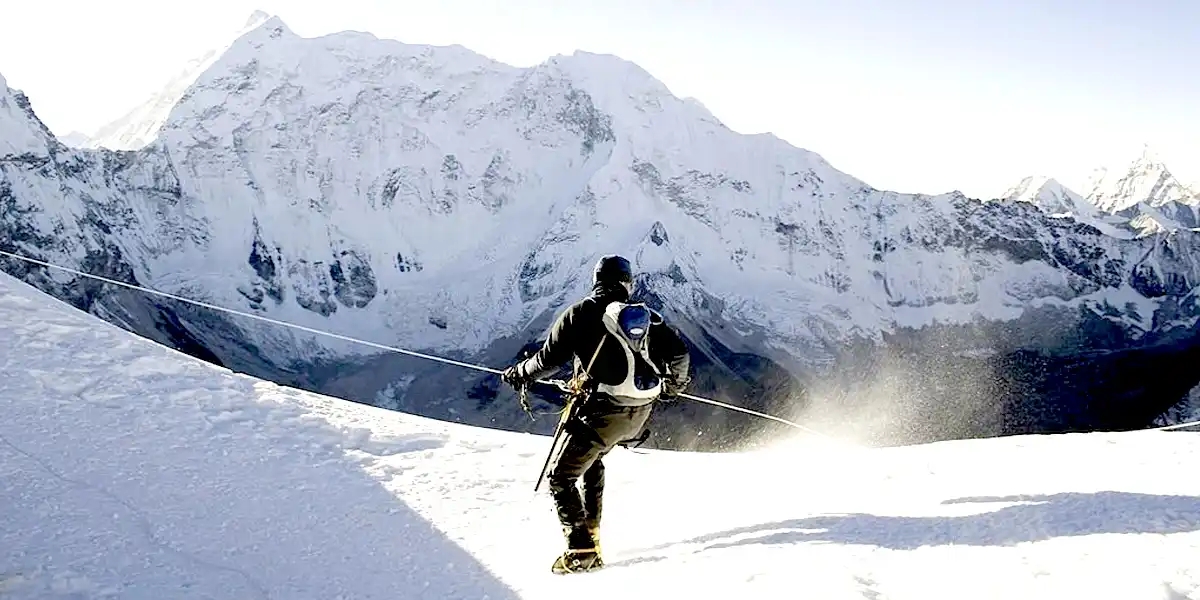


Looking through the deep in the towering range of the Himalayas, there lies the Island peak, a scenery that calls you for adventure. Locally known as “Imja Tse”, promises a mountaineering experience that you never forget through a blend of nature and technical expertise without damaging the natural beauty in the wild. This blog calls to embark you on the trek exploring the world of Island Peak climbing, its risks, accomplishments, and entertainment throughout the journey.
Island Peak, also known as Imja Tse, is a breathtaking mountain in Nepal's Khumbu region, within the Sagarmatha National Park. Because of its difficult yet accessible nature, it is a favorite choice for climbers. Island Peak, also known as Imja Tse, towers over the Nepalese Himalayas at 6,189 meters (20,305 ft) above sea level. Several factors contribute to its prominence as a climbing destination. For starters, it is easily accessible via Lukla Airport, which serves as a convenient entry point to the Everest region. This accessibility is matched with breathtaking landscapes, providing climbers with breathtaking views of the Khumbu Valley and prominent peaks such as Everest, Lhotse, Nuptse, and others. Climbers seeking a rewarding mountaineering experience are drawn to Island Peak's technical characteristics, which include crevasses, steep ice and snow slopes, and the usage of fixed ropes and crampons. Furthermore, many people use Island Peak as a great training ground for more difficult ascents in the area, such as Mount Everest.
Furthermore, as climbers cross Sherpa communities and immerse themselves in the lively Sherpa culture, Island Peak gives an enriching cultural experience. This cultural component enriches the climbing adventure. The peak's moderate height, while nevertheless high, is less extreme than that of some of the world's tallest summits, making it more accessible to a broader variety of climbers seeking high-altitude experiences without the extreme elevations of peaks like Everest. Furthermore, Island Peak's relatively easier and less expensive permit acquisition compared to other notable peaks in the vicinity makes it an appealing choice for budget-conscious climbers or those seeking a less crowded climbing adventure. In essence, the combination of Island Peak's accessibility, stunning beauty, technical challenge, cultural immersion, and role as a stepping stone for greater ascents makes it a sought-after destination in Nepal's Everest region.
Climbers must go through extensive training and preparation before setting foot on Island Peak. Physical conditioning, adaptation to high elevations, and mastery of essential mountaineering abilities are all part of this. You have to look at training routines, vital equipment, and the mental toughness required to face the difficult challenges ahead. Climbers with prior hiking and basic mountaineering expertise are recommended for Island Peak. However, sufficient preparation and acclimatization are required before tackling the climb to ensure safety.
Island Peak climbing is best done during the pre-monsoon (spring) and post-monsoon (fall) seasons. During these times, the weather is more consistent, making for excellent climbing conditions. The Island Peak excursion includes more than just the climb; it also includes a beautiful hike to the base camp. Climbers will pass through gorgeous Sherpa communities, thick woods, and unspoiled alpine landscapes on their way to Island Peak Base Camp. We'll investigate the sights, sounds, and cultural interactions that distinguish this portion of the journey.
Climbing Island Peak, also known as Imja Tse, requires special permissions to comply with regulatory and safety procedures in Nepal's Khumbu region. Climbers must have certain permits to climb. The first step in obtaining the necessary permits is to obtain a TIMS Card (Trekkers' Information Management System), which is required for all travelers in Nepal. The Nepal Tourism Board or its affiliated agencies in Kathmandu or Pokhara can provide TIMS cards. Climbers must then obtain an access permit for Sagarmatha National Park, where Island Peak is located. This permission is available from the Nepal Tourism Board or at the Sagarmatha National Park Entry Gate in Monjo, a checkpoint on the Everest Base Camp trek. Climbers must also get an Island Peak Climbing Permit, which is usually provided by the Nepal Mountaineering Association (NMA) or the Ministry of Tourism.
Fees must be paid, and appropriate documentation, such as a climbing itinerary and evidence of insurance, must be submitted. Finally, to assure safety throughout the ascent, climbers are frequently obliged to hire a registered local guide or associate with a recognized trekking firm. A normal Island Peak trip lasts 18 to 21 days, which includes acclimatization, traveling to the base camp, climbing, and descending.
Reaching the summit of Island Peak provides amazing panoramic views of Everest, Lhotse, Nuptse, and other Himalayan peaks. Climbers will have a truly rewarding experience as well as a remarkable trip to the heart of the Himalayas. Climbing Island Peak is a once-in-a-lifetime expedition that blends the grandeur of the Himalayas with the exhilaration of technical mountaineering.
